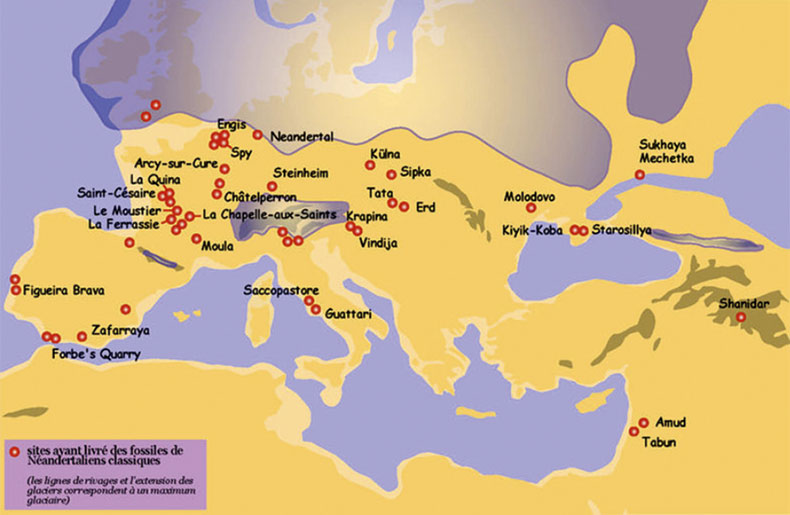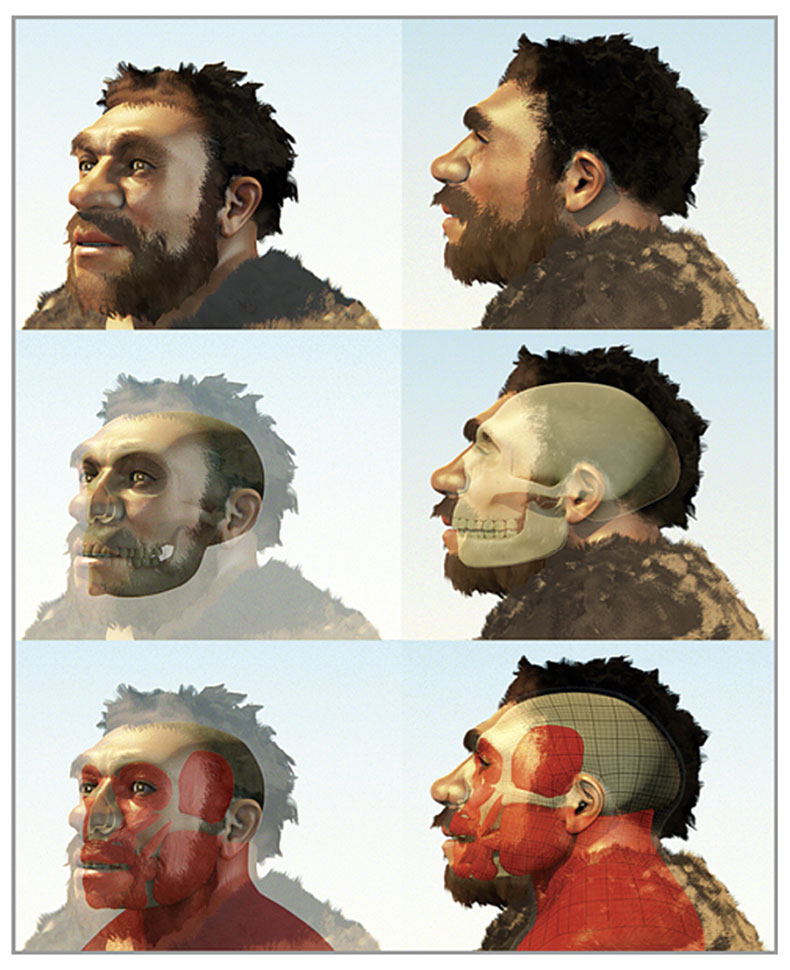I love a love story as much as anyone, and the romance that has had me on tenterhooks for at least 15 years happened (or did it?) over 50,000 years ago. I’m talking about humans and Neanderthals – did they or didn’t they? Science has been tormenting, teasing, and tantalising me with its on-again, offagain reports of human and Neanderthal interbreeding. I read articles on Neanderthals with the enthusiasm of a Miss Lonelyhearts and her Harlequins. I have a personal stake in this I should mention – is that occipital bun at the base of my skull a result of Neanderthal genomes in my DNA? Is that brow ridge of mine a bit on the prominent side?
Part of the confusion appears to have come from early DNA work, especially analysis of Neanderthal mitochondrial DNA – but that just told us there was no human DNA in Neanderthal females. Lately study after study is showing that we do indeed have genomes in our DNA that are derived from Neanderthals, up to ~4% for Eurasians. (Readers are left to speculate on that apparent incongruity...) Recent work is even suggesting that some diseases originate from these genomes we picked up from Neanderthals. Tenuous connections between conditions prevalent among Eurasians, such as autism, and genomes derived from hybridization are being investigated.
I have a relative afflicted with Behçet’s disease, of Lebanese ancestry on her father’s side. The disease is most common in the Middle East, the area where the most interbreeding would have happened, and research has established a link between it and Neanderthal genomes. (Sample, 2011)
The name Neanderthal (or its modern version Neandertal) has an interesting origin. A 17th century pastor named Neumann known for his musical compositions signed his works with the more elegant Greek version of his name, Ne [new] ander [man]. He loved the little valley through which the Düssel River flowed, down towards its confluence with the Rhine a little to the west, in Düsseldorf, and celebrated it in his works. Eventually the valley took on his name – thal is German for valley. In 1856 lime excavators found Neanderthal bones in the valley walls, and a local schoolteacher / amateur scientist identified them as a different species. The bones found their way to the University of Bonn, and that was the beginning of the story. (van der Dennen)
In 1859 Darwin published The Origin of the Species, and the scientific community was off and running like an army of ants, excavating and interpreting rocks and fossils the world over. Neanderthal man has remained at the centre of the evolution debate, and I point those interested to the following website to read a highly entertaining exchange between some scientists (evolutionists) and a creationist author who has written a book arguing that Neanderthal bones are the remains of Noah, Shem, Ham, and Japheth, and their descendants, all several hundred years old (Genesis 9:10) – http://www.talkorigins.org/faqs/homs/cuozzo_cg.html
Evidence from the Old Testament notwithstanding, the current scientific consensus holds that Homo sapiens (that’s us) and Homo (sapiens) neanderthalensis derived from a common ancestor between 500,000 and 200,000 years ago; that ancestor was either a late form of Homo erectus, the archaic form of Homo sapiens, or Homo heidelbergensis. At any rate, archaeological evidence shows that Neanderthals were well established in Europe and West Asia starting 200,000 years ago, and then disappeared from the fossil record about 30,000 years. This means they overlapped with humans for at least 15,000 years, probably much more. Many sites show that they inhabited the same caves, albeit perhaps not at the same time. Neanderthal man was adapted for the late Pleistocene ice age climate, and it is likely that the zone of geographical overlap between the two species moved north and south with interglacial advances and retreats.

Taking a step back, it is useful to view the Neanderthal story within the context of the larger human evolutionary path. This is a field of very active scientific debate, with two main camps of thought representing the end points of the discussion, and a newly popular hybrid of the two emerging up the middle. Proponents of the replacement model hold that modern humans evolved in Africa about 200,000 ya, and then spread out rapidly across the globe, replacing all previous humanoid forms due to their superior intellects and technologies. The regional continuity model argues that there was a continual evolution in all parts of the populated world, starting about 2m ya, from Homo erectus to Homo heidelbergenisis to Homo sapiens (archaic) to Homo sapiens (modern), with enough contact between regions to keep the evolving species “in synch”, while still allowing some regional differences. While strong evidence exists to support both theories, neither fully explains the fossil record, nor DNA evidence.
The more recent assimilation model combines the replacement and regional continuity theories and posits that modern humans did migrate out of Africa 200,000 ya and partially interbred with archaic human species in the different regions, creating localised hybrid populations with distinct characteristics. Over the eons there would have been some contact and interbreeding between these local hybrid populations, resulting in the current situation where humans are a single species, with some apparent vestigial traces of local hybridization, such as the pronounced occipital bun of many Europeans, or the Homo erectuslike shovel-shaped incisors common among East Asians. While some find the notion of interbreeding implausible, I find it highly likely – one need look no further than Stampede week for evidence of the human predilection for unlikely and ill-advised couplings.
The assimilation theory then would argue that modern Europeans are partially the result of hybridization between Homo sapiens and Homo neanderthalensis which occurred in romantic cave settings throughout Europe, the Levant and West Asia during the last days of the Pleistocene ice age. Finds from the Peştera cu Oase cave in Romania are viewed as strong evidence for this, where bones of a teenage male from about 30,000 ya, especially his skull, show a clear combination of modern Homo sapiens and archaic Homo neanderthalensis features.
While the idea of human – Neanderthal interbreeding is interesting, what I find really fascinating is imagining a time when humans coexisted with several different humanoid species. The Neanderthals are one, and the Denisovans of Russia’s Altai Mountains are another; science seems to have accepted the existence of Homo floresiensis as a separate species co-existing with humans in the Indonesian archipelago until ~12,000 ya; a skull found in the Iwo Eleru cave in Nigeria suggests at least one archaic form of human was alive as recently as ~13,000 ya (Boettcher, 2011). Imagine crossing paths with creatures that shared some of the traits we think define us – speech, music, complex social structures, empathy, spiritual feelings, etc.
One contested artifact from Slovenia connects the Neanderthals with musical ability. A hollowed out bear femur with at least four holes drilled in a line has been identified as a diatonic scale flute by several experts, although some others claim it was created by Cro- Magnons (Wikipedia, 2012). More conclusive evidence shows they expressed themselves through art, conducted some sorts of rituals around death and burials, and cared for sick and injured fellow Neanderthals. The image of the Neanderthal as closer to ape than human has switched around, and scientists now believe they were quite similar to humans (Alper, 2003). Imagine our ancestors huddled around a fire in a cliff overhang, while just up the valley in a different cave can be heard the Neanderthal neighbours...

References
Alper, J. (2003, June). Rethinking Neanderthals. Retrieved November 18, 2012, from Smithsonian: http://www.smithsonianmag.com/science-nature/neanderthals. html?c=y&page=2
Boettcher, D. (2011, September 16). Skull points to a more complex human evolution in Africa. Retrieved November 18, 2012, from BBC: http://www.bbc.co.uk/news/science-environment-14947363.
Sample, I. (2011, August 25). The downside of sex with Neanderthals. Retrieved November 22, 2012, from The Guardian: http://www.guardian.co.uk/science/blog/2011/aug/25/neanderthal-denisovan-genes-humanimmunity.
van der Dennen, J. M. (n.d.). The Continuing Story of Neandert(h)al Man: Book Review Essay. Retrieved November 22, 2012, from Homepage dr J.M.G. van der Dennen: http://rint.rechten.rug.nl/rth/dennen/neander.htm
Wikimedia Foundation, Inc. (2012, November 22). Neanderthal. Retrieved November 22, 2012, from Wikipedia: http://en.wikipedia.org/wiki/Neanderthal.
Wikipedia. (2012, October 12). Divje Babe flute. Retrieved November 2012, 2012, from Wikimedia Foundation, Inc.: http://en.wikipedia.org/wiki/Divje_Babe_flute











Share This Column